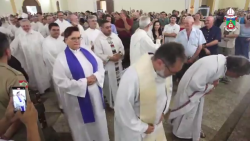Canon 908 of the Code of Canon Law forbids Catholic priests from concelebrating the Eucharist with ministers of Churches or ecclesial communities not in full communion with the Catholic Church.
Newsroom (16/02/2025 Gaudium Press) On February 9th, 2025, the installation mass for the Archdiocese of Chapecó, held at the Cathedral of Santo Antônio in Santa Catarina, became the center of controversy. Vivian Schwanke de Oliveira, a minister of the Anglican Episcopal Church of Brazil (IEAB), participated as one of the concelebrants, standing alongside Catholic priests and bishops. This event, which should have been a significant religious moment, quickly became a hot topic due to the presence of an Anglican minister ‘concelebrating’ a Catholic Mass.
The Role of the Anglican Minister in the Mass
During the mass, Mrs. de Oliveira, wearing a liturgical attire, participated in the procession and even received communion alongside the Catholic clergy. Her presence was striking, especially since she is not part of the Catholic Church, which raised questions about liturgical norms.
The Church’s Response
After ACI Digital raised concerns about the incident, the Archdiocese of Chapecó issued a clarification, apologizing for the oversight and assuring that it had informed the Apostolic Nunciature about the situation. Archbishop Odelir José Magri confirmed that the incident was an unintended violation of the Church’s liturgical rules.
What Does This Mean for Catholic Doctrine?
The presence of Mrs. de Oliveira at the altar is troubling for many, especially considering the Catholic Church’s stance on the ordination of women and the requirements for valid sacramental participation. As outlined in Canon 908, the Catholic Church does not allow concelebration with ministers from ecclesial communities that do not have apostolic succession.
For numerous observers, the presence of an Anglican minister during such a significant moment raises concerns. Many fear that it could be perceived as a sign of acceptance of women’s ordinations, which goes against Catholic doctrine.
Compiled by Donna Smolders


































